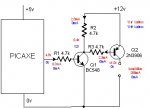danners430
Member
Hey guys,
Yet another technical query - this time to do with relays controlled by a picaxe chip. The relays I'm using are the ones listed on the picaxe store, and after doing some reading in the picaxe manuals, it seems I need a transistor driver to power the relays - is this the case?
The picaxe store doesn't have datasheets for the relay, so I don't know what current it draws, whether its above the 20mA source limit for the chip! Will it work connected directly to the chip, without any drivers, as I only need it to be powered for a few ms (10-50 ms) at a time?
many thanks gents
Yet another technical query - this time to do with relays controlled by a picaxe chip. The relays I'm using are the ones listed on the picaxe store, and after doing some reading in the picaxe manuals, it seems I need a transistor driver to power the relays - is this the case?
The picaxe store doesn't have datasheets for the relay, so I don't know what current it draws, whether its above the 20mA source limit for the chip! Will it work connected directly to the chip, without any drivers, as I only need it to be powered for a few ms (10-50 ms) at a time?
many thanks gents






